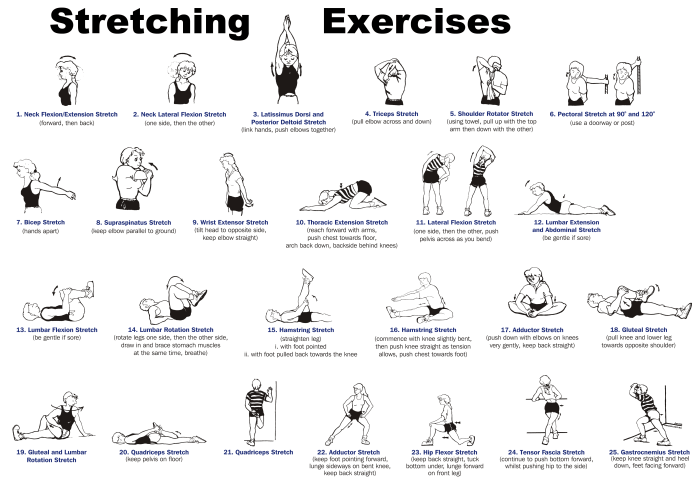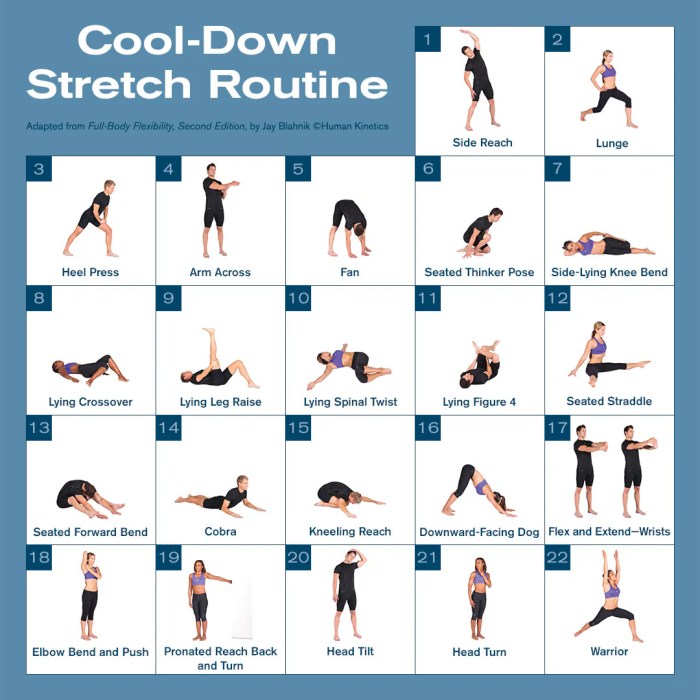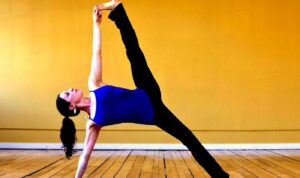Stretching routines are key to enhancing flexibility, strength, and preventing injuries. Dive into the world of stretching exercises and optimal practices for a healthier lifestyle.
Learn about the benefits, types of exercises, best practices, and incorporating stretching into your daily routine for maximum effectiveness.
Benefits of Stretching Routines
Stretching routines are a crucial component of any fitness regimen, offering a wide range of benefits that contribute to overall health and well-being. Incorporating stretching into your workout routine can have a positive impact on your flexibility, muscle stiffness, and athletic performance.
Improved Flexibility
Stretching exercises help to increase flexibility by lengthening the muscles and improving their elasticity. This enhanced flexibility can lead to improved range of motion in joints, allowing for better movement and reduced risk of injury during physical activities.
Reduced Muscle Stiffness
Regular stretching routines can help alleviate muscle stiffness and soreness by increasing blood flow to the muscles and promoting relaxation. This can lead to quicker recovery after workouts and improved overall muscle function.
Enhanced Athletic Performance
By incorporating stretching into your fitness routine, you can improve your athletic performance in various activities. Increased flexibility and reduced muscle stiffness can help you move more efficiently, generate more power, and reduce the risk of muscle strains or tears during exercise or sports.
Prevention of Injuries
Stretching routines play a key role in preventing injuries during physical activities by preparing the muscles and joints for movement. Proper stretching can help improve muscle coordination, balance, and posture, reducing the likelihood of strains, sprains, or other injuries.
Types of Stretching Exercises

Stretching exercises come in various forms, each with its unique benefits and purposes. Let’s explore different types of stretching exercises and their specific advantages.
Static Stretching
Static stretching involves holding a specific position for an extended period, typically 15-30 seconds. This type of stretch helps improve flexibility and can be beneficial for cooling down after a workout. Examples include the calf stretch, hamstring stretch, and shoulder stretch.
Dynamic Stretching
Dynamic stretching involves moving parts of your body through a full range of motion in a controlled manner. This type of stretch helps improve blood flow, increase body temperature, and prepare muscles for activity. Examples include leg swings, arm circles, and walking lunges.
Ballistic Stretching
Ballistic stretching involves using momentum to stretch muscles beyond their usual range of motion. This type of stretch can be effective for improving flexibility quickly but carries a higher risk of injury if not done properly. Examples include bouncing toe touches and bouncing split stretches.
Proprioceptive Neuromuscular Facilitation (PNF) Stretching
PNF stretching involves a combination of stretching and contracting muscles. This type of stretch is often done with a partner and is highly effective for increasing flexibility. Examples include the contract-relax method and the hold-relax method.
Best Practices for Effective Stretching

Stretching is a crucial component of any fitness routine, but it’s essential to do it correctly to reap the maximum benefits and avoid injuries. Here are some best practices to follow:
Importance of Warming Up, Stretching routines
Before diving into your stretching routine, it’s vital to warm up your muscles. This helps increase blood flow, making your muscles more pliable and less prone to injury. A quick 5-10 minute warm-up can include light cardio exercises like jogging in place or jumping jacks.
Tips for Proper Stretching
– Always stretch slowly and gently, never forcing your body into a stretch that causes pain.
– Hold each stretch for at least 15-30 seconds to allow your muscles to relax and lengthen.
– Focus on major muscle groups like hamstrings, quads, calves, and shoulders.
– Breathe deeply and steadily while stretching to help relax your muscles.
– Avoid bouncing or jerking movements, as they can cause muscle strain.
Optimal Duration and Frequency
– Aim to stretch at least 2-3 times a week to maintain flexibility and prevent muscle tightness.
– Each stretching session should last around 15-30 minutes, targeting different muscle groups each time.
– For maximum effectiveness, incorporate stretching into your daily routine, such as after a workout or before bed.
Remember, proper stretching techniques combined with consistency are key to improving flexibility, preventing injuries, and enhancing overall performance in physical activities. Stay safe and enjoy the benefits of a well-rounded stretching routine!
Incorporating Stretching into Daily Routine
As high school students, finding time to incorporate stretching into our daily routine can be challenging with classes, homework, and extracurricular activities. However, adding stretching exercises to our day can improve flexibility, reduce stress, and boost overall well-being.
Strategies for Busy Schedules
When you have a hectic schedule, it’s essential to find creative ways to fit in stretching:
- Wake up a few minutes earlier to do a quick stretching routine before starting your day.
- Take short stretching breaks between study sessions or classes to rejuvenate your mind and body.
- Incorporate stretching into your workout routine by combining it with other exercises like yoga or Pilates.
Benefits of Combining Stretching with Other Exercises
Integrating stretching with other forms of exercise can enhance your overall fitness level:
- Yoga combines stretching with breathing exercises and meditation, promoting relaxation and mindfulness.
- Pilates focuses on core strength and flexibility, complementing stretching routines for a balanced workout.
- Combining stretching with cardio or strength training can improve performance, prevent injuries, and speed up recovery.
Examples of Stretching Routines
Here are some simple stretching exercises that you can do at home or in the office:
- Neck Rolls: Gently roll your neck in circles, clockwise and counterclockwise, to release tension in the neck and shoulders.
- Hamstring Stretch: Sit on the floor with one leg extended and the other bent. Reach for your toes to stretch the back of your thigh.
- Desk Shoulder Stretch: While seated at your desk, clasp your hands behind your back and straighten your arms to open up your chest and shoulders.
